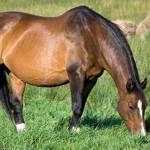Fescue: A Danger to Pregnant Mares

In many parts of the world, horse pastures contain a fair percentage of fescue, a hardy perennial grass that thrives despite heavy hoof traffic, intense grazing, and adverse growing conditions. Unfortunately, there’s a drawback: 75% of all fescue is infected with the endophyte Acremonium coenophialum.
An endophyte is a fungus that grows inside another plant without detriment to the host plant. In some instances, the fungus actually provides benefit to the host plant. Such is the case with Acremonium coenophialum. The fungus produces alkaloids, and these alkaloids protect the plant against certain natural insults such as insects and nematodes. Because of their increased durability, the plants become more tolerant to marginal soils and suboptimal growing conditions.
Endophyte-infected tall fescue causes legions of problems, collectively called fescue toxicosis, in broodmares: prolonged gestation (as long as 13 to 14 months), foaling difficulties, thickened placentas (including “red bag” emergencies), and a decrease or complete absence of milk upon delivery. The ill effects of tall fescue consumption can continue beyond foaling frustrations, as affected mares may be hard to get back in foal, leaving breeders with a smaller foal crop the following year.
Removing mares from endophyte-infected tall fescue 90 days before foaling has been an effective management technique. However, grazing is not the only way mares can come in contact with fescue, as hay and bedding may also contain the dangerous forage.
Grass hay is often described as “mixed.” A mixed grass hay may include fescue, and that fescue might be infected with endophyte which is as detrimental in hay as it is in fresh forage. While fescue is easy to identify in pastures and hayfields, it tends to blend with other grasses as it dries. Like other grasses such as bluegrass and orchardgrass, tall fescue leaves roll into a tight cylinder during the curing process, making a positive identification problematic. Though commercial tests are available to detect the fungus in living plants, there is no such test for the presence of the endophyte in hay. Therefore, when purchasing hay for pregnant mares, be sure it is free of fescue. If fescue is discovered, the hay should be fed to other horses or livestock. Endophyte-infected fescue causes few side effects in non-pregnant mares.
Hay containing mature fescue is not as palatable as some other types, and left-over hay sometimes ends up being used as bedding. If mares consume the bedding, they increase their risk for fescue toxicosis. As a precaution, an experienced agronomist or other specialist should inspect discarded or inferior forage before it is used to bed down the stalls of mares in late gestation. Further, used bedding that has been stripped from stalls should not be strewn on fields grazed by mares. Seed may fall from the dried plants and germinate in the field, thus contaminating the fields and necessitating complete renovation of pasture areas if they’re to be used for grazing mares.








